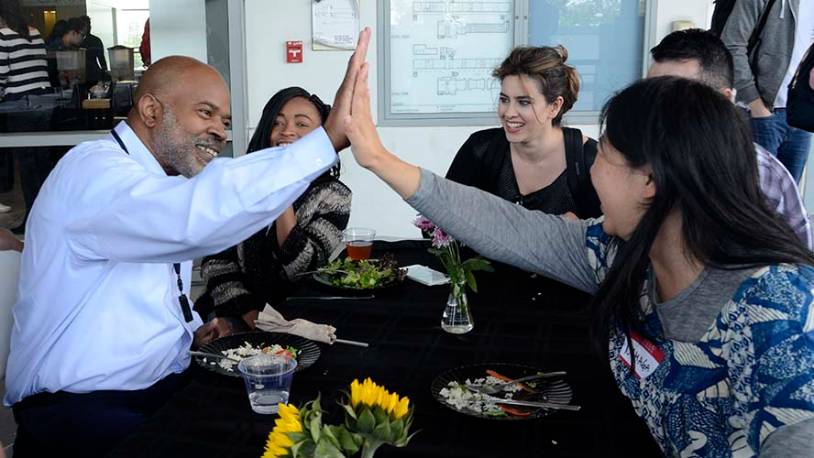
“Drop or fail: Are these my only choices?” That’s the question many—especially underrepresented and minority students—face when taking science classes. And the answer—plus some alternatives to consider—just might depend heavily on the instructor.
Santa Monica College biochemistry student Maria Cabrera Abad offers an example of the dilemma: “On the first day of class, a teacher said, ‘If you have any questions, I should be your last resource. Ask your peers, look it up online, learn how to figure things out on your own.’ That attitude doesn’t make anyone want to ask anything for fear of being told it’s a dumb question.”
“We teach the way we were taught,” says Dr. Jamey Anderson, SMC Physical Sciences Department Chair. “That’s not always a good thing.”
To shift that dynamic, Dr. Anderson, Chemistry Professor Muriel Walker-Waugh, and the Life and Physical Sciences departments teamed up with SMC’s Black Collegians, Adelante, and STEM programs. The Forum on Cultural Diversity in the Sciences is the result of their creative thinking, and the idea driving it is simple: students and faculty would build rapport by meeting outside the classroom over a series of lunches each semester, and engaging in focused activities together.
Nationwide and at SMC, research shows that underrepresented and minority students drop out of classes in the sciences at substantially higher rates than other student populations, with even fewer going on to upper-division courses or transferring to four-year programs. The most disproportionate impact is felt among African American and Latino/a students, particularly males. SMC—through a campus-wide effort driven by the Student Equity Plan and the STEM program—is working to reduce these gaps in achievement.
And improving student-teacher relations seems to be one way to get there.
The Forum won a $15,000 President’s Circle Award for Innovation grant from the Santa Monica College Foundation to fund the lunches and activities, with a goal of holding three lunches per semester, in addition to training for faculty.
“At first the proposal seemed, forgive the pun, not to have enough meat on its bones,” said Lizzy Moore, Interim Dean of Institutional Advancement at the SMC Foundation. “But they brought in students to talk about the idea of dialoguing over a meal, and it was quite compelling as an effective approach to breaking down barriers and helping students achieve.”
The first lunch took place at the SMC Bundy campus on March 29, facilitated by Dr. Carlos Gutierrez, an award-winning mentor and chemistry professor at Cal State University Los Angeles. Dr. Gutierrez engaged instructors and students in a group activity, focusing on how to generate and refine research questions.
“Science is not passive,” he told them. “If all you’re doing is going to lectures, taking notes, and reading your textbook, you’re being cheated. Community is a necessity in science education, because knowledge is created in research groups.”
The exercise Dr. Gutierrez led had two aims: to give students the confidence to ask questions in class, and to encourage students to go ask questions during faculty office hours. “The goal of science,” he said, “is to ask the right questions, not just generate answers.”
Professor Walker-Waugh—who has struggled with these types of barriers in her own life—takes a warm, but no-nonsense approach that sometimes results in students referring to her as “Mom.”
“Sometimes, there’s an underlying preconceived notion that these students aren’t capable,” says Walker-Waugh. “I nurture my students, but they also know that if they don’t perform, I won’t let them get away with it!” Thirty of her students regularly attend office hours with her.
Pre-med student Eniola Emole praised that approach. “Professor Waugh is one of the best teachers I’ve ever had,” she said. “She doesn’t make you feel like an idiot for asking questions, and you can see she wants everyone to understand the material to prepare us for the next level. We know that she is not putting us down, that she’s trying to push us up.”
Dr. Anderson points out that underrepresented students often come into class already feeling like they don’t belong. “So when a professor opens a class with ‘40% of you will not pass this course,’ it’s even more discouraging to them,” he says. “They might not yet understand that struggle is a shared part of the process of learning science. A professor can do a lot to encourage students by sharing a bit about their own personal experiences—saying things like ‘I was good in chemistry but really awful in physics.’ It helps to humanize us.”
He adds that the lunches are a great way to break down those barriers by giving students the chance to see faculty as “mentors, friendly faces…not just people who are grading your papers.”
Students outnumbered faculty 3 to 1 at the first lunch, so there appears to be a hunger for this kind of interaction. Dr. Anderson points out that the interest and participation of instructors will be key to the Forum’s success.
“If we can just get faculty to talk to students, to break bread together, get to engage in activities together…I think that we will break down these barriers,” said Walker-Waugh. “Students just want to know that you care.”



